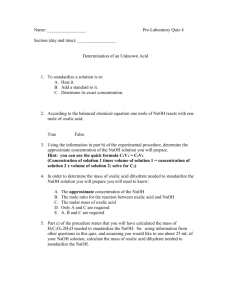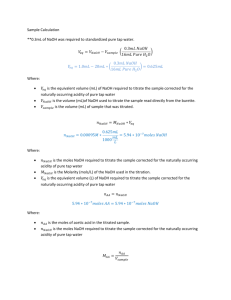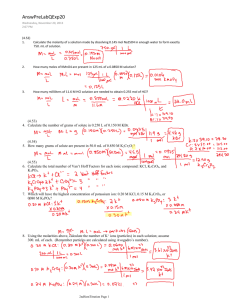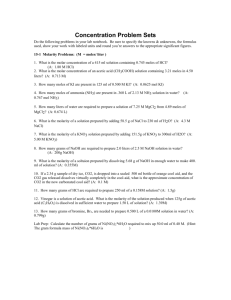Titraton of Vinegar
advertisement
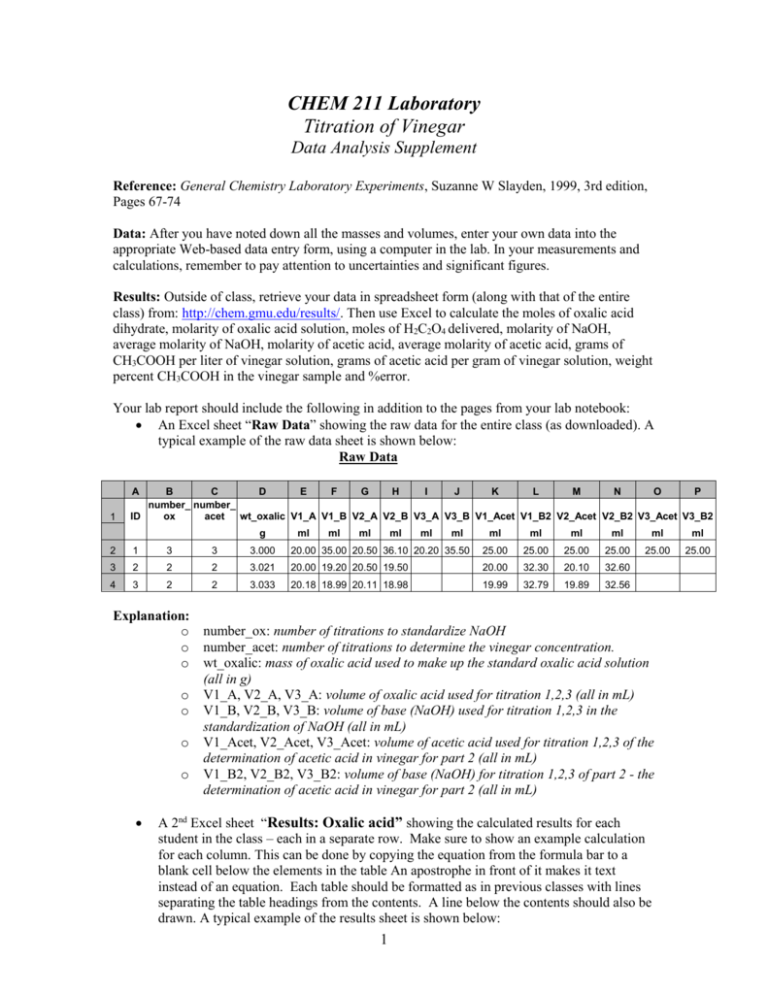
CHEM 211 Laboratory Titration of Vinegar Data Analysis Supplement Reference: General Chemistry Laboratory Experiments, Suzanne W Slayden, 1999, 3rd edition, Pages 67-74 Data: After you have noted down all the masses and volumes, enter your own data into the appropriate Web-based data entry form, using a computer in the lab. In your measurements and calculations, remember to pay attention to uncertainties and significant figures. Results: Outside of class, retrieve your data in spreadsheet form (along with that of the entire class) from: http://chem.gmu.edu/results/. Then use Excel to calculate the moles of oxalic acid dihydrate, molarity of oxalic acid solution, moles of H2C2O4 delivered, molarity of NaOH, average molarity of NaOH, molarity of acetic acid, average molarity of acetic acid, grams of CH3COOH per liter of vinegar solution, grams of acetic acid per gram of vinegar solution, weight percent CH3COOH in the vinegar sample and %error. Your lab report should include the following in addition to the pages from your lab notebook: An Excel sheet “Raw Data” showing the raw data for the entire class (as downloaded). A typical example of the raw data sheet is shown below: Raw Data A 1 B C D E F G H I J K L M N O P number_ number_ ID ox acet wt_oxalic V1_A V1_B V2_A V2_B V3_A V3_B V1_Acet V1_B2 V2_Acet V2_B2 V3_Acet V3_B2 ml ml ml ml ml ml 2 1 3 3 3.000 20.00 35.00 20.50 36.10 20.20 35.50 25.00 25.00 25.00 25.00 25.00 25.00 3 2 2 2 3.021 20.00 19.20 20.50 19.50 20.00 32.30 20.10 32.60 4 3 2 2 3.033 20.18 18.99 20.11 18.98 19.99 32.79 19.89 32.56 g ml ml ml ml ml ml Explanation: o number_ox: number of titrations to standardize NaOH o number_acet: number of titrations to determine the vinegar concentration. o wt_oxalic: mass of oxalic acid used to make up the standard oxalic acid solution (all in g) o V1_A, V2_A, V3_A: volume of oxalic acid used for titration 1,2,3 (all in mL) o V1_B, V2_B, V3_B: volume of base (NaOH) used for titration 1,2,3 in the standardization of NaOH (all in mL) o V1_Acet, V2_Acet, V3_Acet: volume of acetic acid used for titration 1,2,3 of the determination of acetic acid in vinegar for part 2 (all in mL) o V1_B2, V2_B2, V3_B2: volume of base (NaOH) for titration 1,2,3 of part 2 - the determination of acetic acid in vinegar for part 2 (all in mL) A 2nd Excel sheet “Results: Oxalic acid” showing the calculated results for each student in the class – each in a separate row. Make sure to show an example calculation for each column. This can be done by copying the equation from the formula bar to a blank cell below the elements in the table An apostrophe in front of it makes it text instead of an equation. Each table should be formatted as in previous classes with lines separating the table headings from the contents. A line below the contents should also be drawn. A typical example of the results sheet is shown below: 1 Results: Oxalic acid A B mol Oxalic [Ox] M C n1_Ox used D n2_Ox used E n3_Ox used F n1_NaOH used G n2_NaOH used H I J K L n3_NaOH used [NaOH]1 [NaOH]2 [NaOH]3 [NaOH]ave 1 moles moles moles moles moles moles moles M M M M 2 0.0238 0.238 0.0048 0.0049 0.0048 0.0095 0.0098 0.0096 0.272 0.270 0.271 0.271 3 0.0240 0.240 0.0048 0.0049 0.0096 0.0098 0.499 0.504 0.502 4 0.0241 0.241 0.0048 0.0048 0.0097 0.0096 0.511 0.510 0.151 Explanation: o mol Oxalic: moles of oxalic acid dihydrate used to prepare standard solution (moles) o [Ox]: molarity of oxalic acid solution (M) o n1_Ox used, n2_Ox used, n3_Ox used : moles of oxalic acid dihydrate used for standardizing sodium hydroxide (all in moles) o n1_NaOH used, n2_NaOH used, n3_NaOH used: moles of sodium hydroxide used to neutralize oxalic acid (all in moles) o [NaOH] 1, [NaOH] 2, [NaOH] 3: molarity of sodium hydroxide (all in M) o [NaOH] ave: average molarity of sodium hydroxide (M) A 3rd Excel sheet “Results: Acetic acid” showing the rest of the calculated results. A typical example of the results sheet is shown below: Results: Acetic acid A B C D n1_NaOH used n2_NaOH used n3_NaOH used [Acetic]1 E F [Acetic]2 [Acetic]3 G H I J [Acetic]ave g Acet/L soln wt% %Error 1 moles moles moles M M M M g/L 2 0.0068 0.0068 0.0068 0.271 0.271 0.271 0.271 16.278 1.62 61.90 3 0.0162 0.0164 0.810 0.814 0.812 48.758 4.85 2.97 4 0.0167 0.0166 0.837 0.836 0.836 0.00 50.256 5.00 5 Average = 3.82 6 StdDev = 1.91 Explanation: o n1_NaOH used, n2_NaOH used, n3_NaOH used: moles of sodium hydroxide used to neutralize vinegar solution (all in moles) o [Acetic] 1, [Acetic] 2, [Acetic] 3: molarity of acetic acid (all in M) o [Acetic] ave: average molarity of acetic acid (M) o g Acet/L soln: grams of CH3COOH per liter of vinegar solution using average molarity of acetic acid (g/L) o wt%: weight percent of CH3COOH in the vinegar sample o %Error: difference between legal value and experimental value o Average: average weight percent of acetic acid in vinegar solution o StdDev: standard deviation observed in weight percent of acetic acid in vinegar solution 2 A 4th Excel sheet “Histogram” showing a histogram of the distribution of the weight percent results. Use equally spaced “bins” chosen to display the “spread” in the class results. Printing Tables: Large tables should be printed in the landscape mode and sometimes it might be necessary to go to “page setup” and select “Fit to 1 page” to make the page fit on one page. Include column and row headings on the printout so that the instructor can more easily understand equations used. This can be done by going to File → Page Setup → Sheet tab → Select “Row and Column Headings”. Discussion: In your discussion section address the following questions: What is equivalence point and how is it recognized in this experiment? How well does your weight percent acetic acid in vinegar solution agree with the legal standard? How well does the class average agree with the legal value? Are the deviations systematic or random? What are the possible sources of error in this experiment? Refer in your answer to the class histogram as well as to your own results. 3



